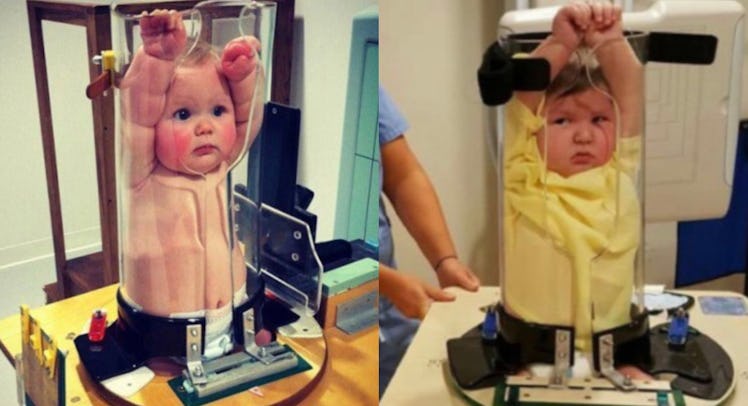Stop Laughing At Babies Getting X-Rays
Come on!

Twitter loves roasting babies. Sometimes, it’s all in good fun, like when parents list all the ways infants annoy the hell out of them. But sometimes, tongue-in-cheek teasing crosses the line to become mean-spirited bullying, like people who thought it was extremely funny to throw cheese at their confused, defenseless kids. And unfortunately, these casually cruel pranksters are once again making babies the butt of the joke in a viral thread that makes fun of what babies look like getting X-rays.
“I just found out this is how they X-ray small children and I can’t stop laughing,” user Ramy Nagdy tweeted on April 29, 2019, along with three photos of young kids squished into some sort of clear tube contraption.
Apparently, baby X-rays are something known as a Pigg O Stat, in which children between the ages of 12 months and 3 years old are put in for X-rays to keep them immobilized while also protecting them from exposure to harmful radiation.
And while the Pigg O Stat is practical, it’s clearly uncomfortable, and even frightening, for many of the kids who were forced to endure the strange baby X-ray. But that didn’t stop the masses from quickly chiming in on the original post with everything from “clever” captions to pictures of their own kids squished inside the baby X-ray equipment.
In the photos shared by other parents, the kids all have a similar expression on their faces: a mixture of wide-eyed confusion, shock, and fear.
Another person even compared the babies to the scene in Willy Wonka and the Chocolate Factory when Augustus Gloop gets stuck in the chocolate test tube. It’s all very funny until you remember Gloop was essentially being punished by Wonka for his gluttony.
While most people were laughing over the pictures, some parents whose children had used the baby X-ray aka the Pigg O Stat said that the experience was anything but funny, with some calling it “traumatizing” for their babies.
This article was originally published on